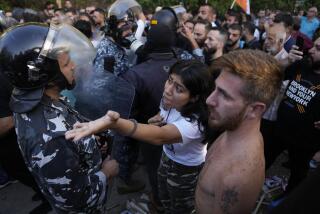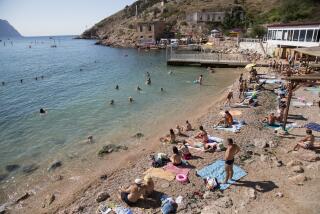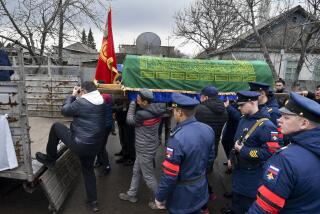After 45 Years, Crimea Beckons to Ousted Tatars : Soviet Union: Banished by Stalin, more than 100,000 have returned to their homeland.
- Share via
KORYEIZ, Soviet Union — Osman Osanov was 14 years old when Soviet troops forced him and his family out of their farmhouse near the Black Sea city of Yalta and put them into crowded cattle cars heading east. Now, gray-haired and pot-bellied, he has come back to reclaim a piece of his homeland.
“We never gave up hope,” Osanov, 58, a truck driver, said. “Each year we expected to return. We never stopped thinking about our homeland.”
Banished en masse by order of dictator Josef Stalin in May, 1944, on suspicion of collaborating with occupying Nazi troops during World War II, the Crimean Tatars have struggled for years to return from exile in some of the Soviet Union’s remotest areas.
More than 100,000 have now made it back to the Crimea, a Black Sea peninsula about half the size of California’s San Bernardino County where they have started 25 small settlements of tents and shacks.
“We lived most of our lives in exile, yearning to be back here,” said Gulizar Abdulayeva, 43, who teaches children their native Tatar language. “Now when our lives are nearing their end, we are finally back in our homeland.”
The government has given some of the returnees land, but in most cases the Tatars have seized land and set up tent cities or have protested at local government offices or gone on public hunger strikes to win the right to stay.
“We are still fighting,” Reshat Ablayev, a construction engineer and nationalist leader, said. “I am 39 years old, and I am not allowed to have a home in my land. When a person is rehabilitated, everything should be given back.”
About 4,000 families are still squatting illegally on plots of land clustered together in settlements across the Crimea, according to Refat Chubarov, 33, a Crimean Tatar nationalist and member of the government commission on resettlement.
In August, Osanov and 65 other Tatars seized a tobacco field at Koryeiz, about five miles from the resort city of Yalta, after camping outside the Communist Party headquarters there for three months to demand land.
They are living in flimsy plywood one-room houses while they build sturdier concrete-block dwellings for the winter. The camp has a single outhouse. Electricity is illegally tapped from nearby power lines, and coal stoves heat their makeshift homes.
The rough living conditions have been tragic for some. Earlier this year, three children died in a fire set off when the gas canister used to heat their tent exploded.
Osanov took a break from building concrete-block homes one afternoon this month and recalled how he and 400,000 others like him were exiled from the Crimea for “betraying their country.”
“We could take nothing with us but the clothes on our backs,” Osanov said. “They put us in a closed railroad car used to transport livestock. When people died, we were not allowed to bury them. They were just tossed out alongside the tracks.”
Descendants of Mongol tribes that joined Genghis Khan in his conquest of Russia and much of Eastern Europe in the 13th Century, Tatars settled in Siberia, along the Volga River, and in the Crimea, where they had their own government until 1783, when they came under Russian rule.
Under Stalin, Soviet rule became oppressive: Many of the Tatars’ mosques were closed and “Russification” was imposed on their children’s education. When German troops occupied the Crimea in World War II, some Tatars welcomed them as liberators. When the Red Army recaptured the territory, Stalin ordered all Crimean Tatars deported.
Human rights activists say almost half of the banished Crimean Tatars died from hunger or sickness during the journey or in the first years of their harsh exile.
Osanov’s journey lasted a month and a half before he arrived in the Central Asian republic of Uzbekistan. There he lived until six months ago. His family remains there, waiting for him to finish their house.
For decades, the Crimean Tatars have tried to return. They were allowed to leave their places of exile in 1967, but local officials prevented most from returning home. Those who did manage to resettle in the Crimea were treated as outcasts. They were forbidden to work and their children were not permitted to attend schools. Most were eventually evicted and sent again to Central Asia or the Ural Mountains.
But Tatar activists kept demanding their right to the land where their ancestors had lived for hundreds of years. Their campaign culminated in the summer of 1987 with unprecedented demonstrations outside the Kremlin.
Two years ago, the government restored to Tatars the right to live in the Crimea; more than 80,000 have returned. A commission was appointed to plan a state-funded resettlement program last year, but the program is still under debate and no government money has yet been provided.
“The government promises it will resettle us,” said Lilya Budzhurova, a Crimean Tatar poet who settled in Simferopol six months ago. “But after 46 years away from our homeland, our people have no more patience and no more faith in anything the government says.”
Mustafa Dzhemilev, the president of the Crimean Tatar National Movement Organization, who spent 15 years in prison for fighting for his people’s right to return, said that money is now one of the major barriers to resettlement.
“They can come only if they can afford to buy their own homes at greatly inflated prices,” Dzhemilev said. “Our people were thrown out of these same houses in 1944, and now we have to spend incredible amounts of money to buy them back.”
When Dzhemilev and his family bought a house last year in the Crimea, it cost the equivalent of $24,000, or as much as the two houses they sold in Uzbekistan.
Another returnee, Ilyas Belalov, 37, who lived most of his life in the Uzbek city of Tashkent, said: “I went back (to Tashkent) and saw my family’s home. Two families live there now. I can’t demand it back.”
For six months, Belalov has been living with 19 other men in an underground bunker while they build homes on land they have illegally occupied near the industrial city of Simferopol. His family is still in Uzbekistan.
“All I want is a piece of land to build a home for my family,” Belalov said. “But the government won’t even give that to me.”
Crimean Tatars say local officials use various tactics to keep them from returning.
“They create policies to keep Crimean Tatars out of the highly populated areas,” Dzhemilev said. “None are allowed to settle along the southern seaside, although historically the majority of Crimean Tatars lived in these areas. This is the place for summer homes for the party bosses from Moscow. They don’t want us there.”
Local officials have also tried to parcel out land before the Tatars can claim it, the nationalists said.
“In the last two years, 100,000 lots have been given for summer houses for other residents of the Crimea who already have homes,” Chubarov said. “They do this so the officials can say there is no land left for the Crimean Tatars.”
But local officials say the Tatars’ demands are unreasonable.
“They demand land not just anywhere in the Crimea but in the most crowded areas, where there are not adequate utilities or jobs,” Alexander I. Balagura, deputy chairman of the local executive committee in charge of Crimean Tatar resettlement, said. “The Russians and people of other nationalities who live here are not at fault and should not suffer.”
The Tatars believe, however, that their rights come first--the land was theirs and they were brutally dispossessed and exiled--and they are determined to fight any attempt to deny these rights.
This fall, angry state farm workers plowed down several plywood shacks built by Tatars at Koryeiz.
“If they threaten us again we will protect ourselves,” nationalist leader Ablayev said. “We tell them, ‘We have gasoline, and we will burn you and ourselves if you touch us.’ We may burn, but we will not lose our homeland again.”
A large sign over the mess hall reminds the 66 residents of Koryeiz of their struggle. It reads: “Homeland or Death.”
More to Read
Sign up for Essential California
The most important California stories and recommendations in your inbox every morning.
You may occasionally receive promotional content from the Los Angeles Times.













